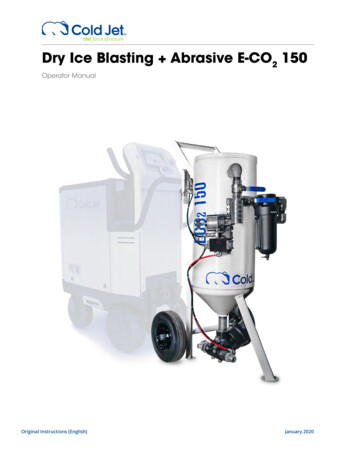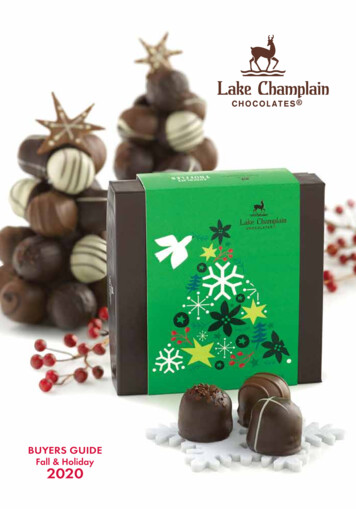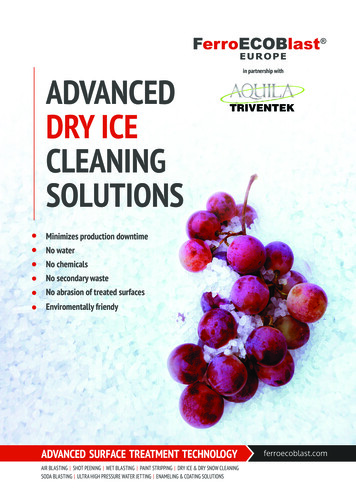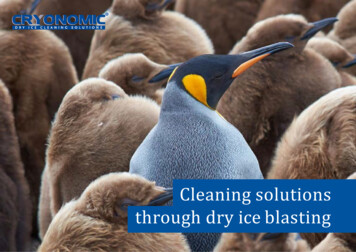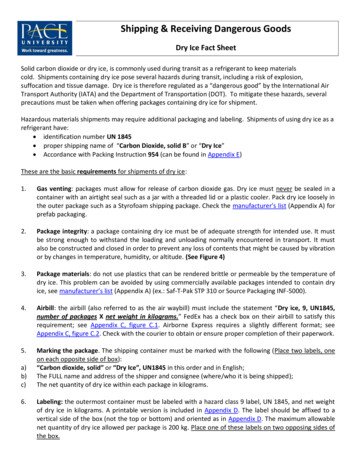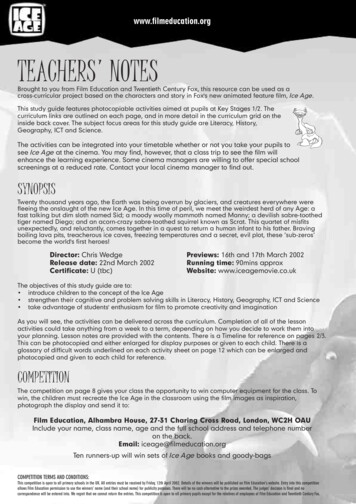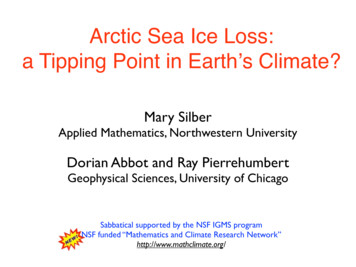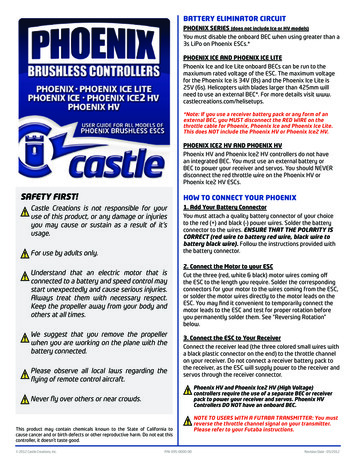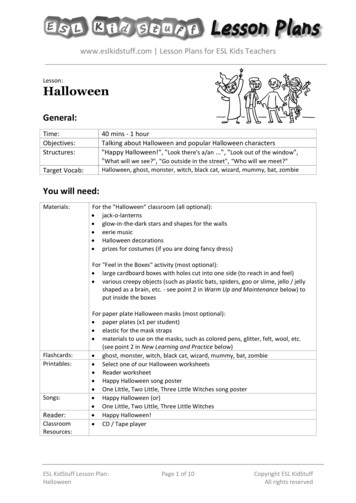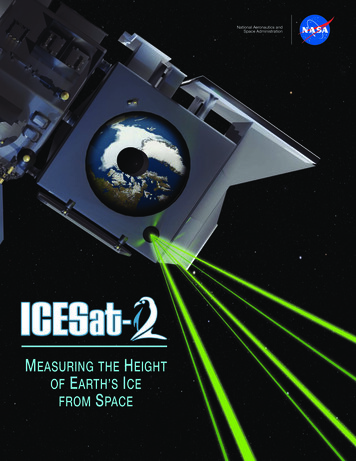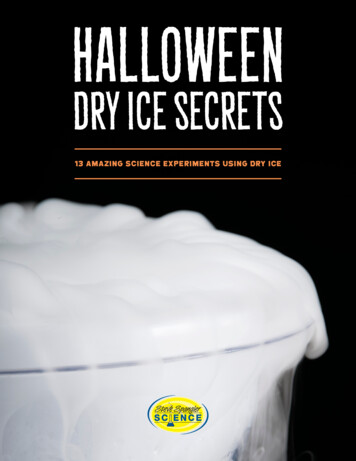
Transcription
HALLOWEENDRY ICE SECRETS13 Amazing Science Experiments Using Dry Ice
DRY ICE SCIENCEHalloween is the perfect time for oozing, bubbling, eye-catching science! If you love to perform science demonstrations,Halloween is a wonderful excuse to fill the cooler with dry ice and get ready for a day filled with “ooze” and ahhhs!BUYING DRY ICEGrocery stores use dry ice to keep food cold duringshipping. Some stores and ice cream shops will sell dryice to the public, especially around Halloween, for about 1 per pound. Dry ice comes as flat square slabs a fewinches thick or as cylinders that are about three incheslong and about a half of an inch thick. Either size willwork fine for your dry ice experiments. Remember, dryice turns from a solid into a gas in a process calledsublimation. In other words, dry ice in a grocery bagwill literally vanish in about a day! The experts tell usdry ice will sublimate (turn from a solid to a gas) at a rateof five to ten pounds every 24 hours in a typical icechest. It’s best to purchase the dry ice as close to thetime you need it as possible. Last minute shopping isnecessary. If you are planning to perform a number ofdry ice demonstrations, plan to purchase 5 to 10 pounds.Visit the video above to find out how to buy dry ice and discoverthe safest way to store it. Having trouble clicking through?Try this URL: http://spanglersci.com/HOWTODRYICEDRY ICE SAFETYFirst of all, here’s the background information and safety lesson on dry ice. Dry ice is frozen carbon dioxide. Under normalatmospheric conditions, carbon dioxide is a gas. Only about 0.035% of our atmosphere is made up of carbon dioxide. Mostof the air we breathe is nitrogen (79%) and oxygen (20%). Instead of melting, dry ice turns directly into carbon dioxide gas butdoes not melt like real ice. Dry ice must be handled with care as it is -109.3 F (-78.5 C). It must be handled using gloves ortongs, as it will cause severe burns if it comes in contact with your skin. Never put dry ice into your mouth. When you drop apiece of dry ice in a bucket of water, the gas that you see is a combination of carbon dioxide and water vapor. So, the gas thatyou see is actually a cloud of tiny water droplets.Halloween Science Secrets Copyright 2014 Steve Spangler Science All Rights Reserved www.SteveSpanglerScience.com 800.223.9080
TRANSPORTING AND STORING DRY ICEYou’ll need a good pair of gloves to handle the dry ice and a beverage cooler like a Styrofoam ice chest to carry it. The insulated container will help to slow down the rate of sublimation. Remember the basic science of dry ice Dry ice turns from a solidinto a gas (sublimation) as it heats up. Since the gas takes up more space than the solid, the container you choose to store andtransport the dry ice must be vented. Never place dry ice in a sealed container! As dry ice turns from a solid into a gas, thevolume increases and the container will explode. It is best not to store dry ice in your freezer. Your freezer’s thermostat will shutoff the freezer due to the extreme temperature of the dry ice. Tricky! It’s best just to store the dry ice in a well ventilated,insulated container until you’re ready to use it.DID YOU KNOW - Dry ice is extremely useful for freezing and keeping things frozen because of its very cold temperature (-109.3 F or--78.5 C). Dry Ice is widely used because it is simple to freeze and easy to handle using insulated gloves.Dry ice gives more than twice the cooling energy per pound of weight and three times the cooling energy per volumethan regular water ice. Dry ice is often mixed with regular ice to save shipping weight and extend the cooling energy ofwater ice.Sometimes dry ice is made on the spot from liquid carbon dioxide. The resulting dry ice snow is packed in the top of ashipping container offering extended cooling without electrical refrigeration equipment and connections.HOW IS DRY ICE MADE?The first step in making dry ice is to compress carbon dioxide gas until it liquefies, at the same time removing the excess heat.The CO2 gas will liquefy at a pressure of approximately 870 pounds per square inch at room temperature. Once liquid CO2 isformed, the CO2 is sent through an expansion valve and enters a pressure chamber. The pressure change causes the liquidto flash into a solid and causes the temperature to drop quickly. About 46% of the gas will freeze into “dry ice snow.” The restof the CO2 gas, 54%, is released into the atmosphere or recovered to be used again. The dry ice snow is then collected in achamber where it is compressed into block, pellet or rice size pieces using hydraulics.Halloween Science Secrets Copyright 2014 Steve Spangler Science All Rights Reserved www.SteveSpanglerScience.com 800.223.9080
COOL THINGS TO DO WITH DRY ICEThe following science experiments and activities require adult supervision. Dry ice is fun and safe to use if all of the safetyprecautions are followed. Just a quick search on the Internet will reveal a bunch of stupid things that people do (or used to dowhen they had all of their fingers!) with dry ice. The best advice we can offer in this guide is to treat dry ice with respect. Alwayswear gloves when handling dry ice, and never seal dry ice in a container. Dry ice bombs are extremely dangerous and result inmany serious injuries every year. Just use common sense and you’ll have fun and learn some cool science at the same time.DISAPPEARING ICEHere’s a quick experiment to help children better understand why it’s called dry ice. Ask the children, “Why do you think theycall this dry ice?” Place a regular ice cube on one plate and a similar size piece of dry ice on a second plate. Keep both platesout of the reach of the children. “Let’s try to guess what is going to happen to the ice cube and the piece of dry ice if we leaveit on the plate for one hour.” Of course, the children are likely to tell you that both pieces of ice will melt, turning into a puddleof water. Allow the children to view the plates after one hour and to discover the difference between real ice and dry ice. Thereshould be a puddle of water on the plate where the real ice was, but the dry ice plate will be “dry.” Where did the dry ice go?Dry ice is not made from water, it’s made from some of the air that we breathe. it’s frozen carbon dioxide. The dry ice turnedinto invisible carbon dioxide gas that disappears into the air. Magic!Visit the video above to hear the screaming ice. Having troubleclicking through? Try this URL: http://spanglersci.com/SCREAMICEBURPING, BUBBLING, SMOKING WATERUse the tongs or gloves to place a piece of dry ice in a glass ofwarm water. Immediately, the dry ice will turn into carbon dioxidegas and water vapor, forming a really cool cloud! This cloud isperfectly safe for the children to touch and feel as long as theydo not put their fingers far enough down into the water toaccidentally touch the dry ice. To create the best effect, be sureto use warm water and add a few drops of food coloring to turnboring water into a bubbling potion. Over time, the dry ice willmake the water cold and the “smoking” will slow down. Replacethe cold water with warm water and you’re back in business!Remember —ALWAYS use gloves ortongs when handling andtransporting dry ice.Halloween Science Secrets Copyright 2014 Steve Spangler Science All Rights Reserved www.SteveSpanglerScience.com 800.223.9080
SMOKING PUMPKINSIt’s easy to make your favorite carved pumpkinsmoke by placing the beaker or glass of bubblingdry ice and water mixture into the pumpkin. Let’sface it dry ice in almost anything “Halloween”works, and who doesn’t like a smoking pumpkin?Click here to see exactly how Steve makesthe smoking pumpkins. Having troubleclicking through? Try this URL:http://spanglersci.com/SMOKINGPUMPKINSMOKING CYLINDERSClick the thumbnail to see smoking cylinders in action! Can’t clickthe thumbnail? Try this URL: http://spanglersci.com/0930223Selecting the correct container for the bubbling dry ice and water makes the activity safer for small children to participate.Instead of using a wide mouth container like a beaker or a household jar, use a graduated cylinder. This is a common pieceof lab equipment for teachers and scientists, but they are easy to find online. The best advice is to find a good quality, plasticgraduated cylinder that holds approximately 1000 mL (about a quart).Fill the graduated cylinder (assuming that you’re using a 1000 mL size) with approximately 250 mL of warm water. Add a fewgood sized pieces of dry ice to start the bubbling action. Here’s the best part notice how children can hold onto the bubbling container but they can’t reach their hands down into the cylinder to touch the dry ice! This is a great way for you to passaround the bubbling concoction without fear of the kids coming in contact with the dry ice.BUBBLING SOAP BUBBLESWho would have guessed that you could have this much fun withsoapy water and a chunk of dry ice? Fill a tall glass or plastic cylinder withwarm water and add a squirt of liquid dish soap like Dawn. Use gloves ortongs to place a piece of dry ice into the soapy water. Get ready for a roomfull of ooohs & ahhhs! Instead of the dry ice just bubbling in the water tomake a cloud, the soap in the water traps the carbon dioxide and watervapor in the form of a bubble. The children will see the bubbles climb outof the cylinder of warm, soapy water and explode with a burst of “smoke”as they crawl over the edge. Add some food coloring to the water to makethe demonstration more colorful. You can give the suds an eerie glow, bydropping a glowing lightstick into the water along with the dry ice.To see bubbling, smoking bubbles. Havingtrouble clicking through? Try this URL:http://spanglersci.com/BUBBLINGSOAPHalloween Science Secrets Copyright 2014 Steve Spangler Science All Rights Reserved www.SteveSpanglerScience.com 800.223.9080
FLOATING BUBBLEYou’ll notice that when you add dry ice to water, the cloud of carbon dioxide and waterdoes not go up into the air, but instead falls towards the ground. Why? This cloud-likemixture of carbon dioxide and water is heavier than the surrounding air. You’ll use thislittle piece of science trivia to perform the amazing Floating Bubble trick. A small fishaquarium works well for this activity. Fill the bottom of the aquarium about an inch deepwith warm water. Use gloves or the tongs to add a few pieces of dry ice. Of course, thedry ice will begin to smoke turning into carbon dioxide and water vapor.Using a bubble wand and a bottle of bubble fluid, blow a few bubbles into the aquarium(it’s a little difficult, so be patient). To everyone’s amazement, a few bubbles will appear tofloat in mid-air in the aquarium. The bubble is really just floating on a cushion of invisiblecarbon dioxide gas. Of course, the spooky Halloween story is up to you, but I’m almostcertain the aquarium is the home of a ghost known to play with soap bubbles!2143TRY A SPOOKY, BUBBLING BEVERAGEThe next time you have a craving for a sparkling beverage, makeyour own batch using what you know about dry ice. Fill a bowl orpitcher with apple juice and use gloves or tongs to add a few largepieces of dry ice. While the mixture is bubbling and burping, theapple juice is being carbonated by the dry ice. Carbon dioxide gasis mixing with the juice to make a “sparkling” drink. Wait until thedry ice is completely gone before serving your carbonated drink.Discover how to make a spooky drink. Having trouble clickingthrough? Try this URL: http://spanglersci.com/BUBBLINGDRINKLIGHTSTICKS. THE EEEEEEERIE GLOW!Make a trip to your local supermarket or Halloween store to find a supply oflightsticks. When you bend the lightstick, a small glass tube breaks and thechemicals in the lightstick mix. The result is an eerie glowing light that is safelycontained within the walls of the lightstick. Drop a lightstick into your bubbling,dry ice potion for a great eerie effect.Halloween Science Secrets Copyright 2014 Steve Spangler Science All Rights Reserved www.SteveSpanglerScience.com 800.223.9080
DRY ICE CRYSTAL BALL BUBBLEIt’s the world’s coolest crystal ball. Create a soap film on therim of the bucket and you’ll have what appears to be a crystalball filled with a cloud-like mixture of water vapor and carbondioxide. When the giant bubble bursts, the cloud of “smoke”falls to the floor followed by an outburst of ooohs & ahhhsfrom your audience.You’ll need a large bucket with a smooth rim, solution of dishsoap and water, piece of cloth 18 inches long, gloves, safetyglasses, and a few pieces of dry ice.Cut a strip of cloth about 1 inch wide and 18 inches long. Anold t-shirt works well. Soak the cloth in a solution of Dawn dishsoap or use your favorite recipe for making bubble solution.Make sure that the cloth is completely soaked. Fill the buckethalf full with water. Have tongs or gloves ready to transfer thedry ice to the bucket.Place two or three pieces of dry ice into the water so that agood amount of fog is being produced. Remove the strip ofcloth from the dish soap and carefully pull the strip across therim. The goal is to create a soap film that covers the top. It alsohelps to have the rim wet before you start.This may take some practice until you get the technique mastered. Remember that a bubble’s worst enemies are dirt, oil,and rough edges. Your patience will pay off in the long run. Ifyou accidentally get soap in the bucket of water, you’ll noticethat zillions of bubbles filled with fog will start to emerge fromthe bucket. This, too, produces a great effect.Place a waterproof flashlight in the bucket along with the dryice so that the light shines up through the fog. Draw the clothacross the rim to create the soap film lid and turn off the roomlights. The crystal bubbles will emit an eerie glow and you’llbe able to see the fog churning inside the transparent bubblewalls. Take your bows as the class erupts in a chorus of ooohs.See the steps to the Dry Ice Crystal Ball. Trouble clicking?Try this URL: http://spanglersci.com/DRYICEBUBBLEHalloween Science Secrets Copyright 2014 Steve Spangler Science All Rights Reserved www.SteveSpanglerScience.com 800.223.9080
The rst step in making dry ice is to compress carbon dioxide gas until it liquees, at the same time removing the excess heat. The CO2 gas will liquefy at a pressure of approximately 870 pounds per square inch at room temperature. Once liquid CO2 is formed, the CO2 is sent through an expansion valve and enters a pressure chamber.
